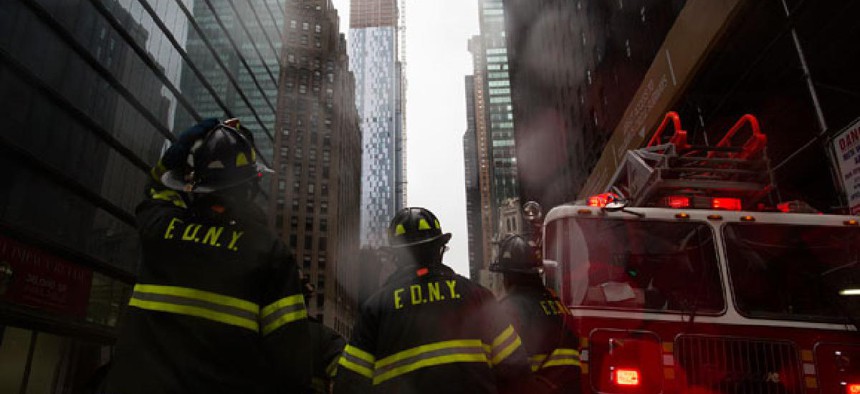Military sends aerial maps of Sandy damage to FEMA smartphones

Firefighters respond to a call during the storm in New York Monday. John Minchillo/AP
Responders can see the imagery on mobile devices even when cell service drops.
The Pentagon is feeding civilian first responders satellite imagery of storm damage through their smartphones, according to the Defense Department.
The military’s mapping office, the National Geospatial-Intelligence Agency, is providing the graphics so that the Federal Emergency Management Agency can allocate resources appropriately in the wake of Hurricane Sandy, NGA officials said. First responders can obtain -- and store -- the information through several communications channels in case connectivity fails. Due to power outages and physical damage in savaged areas, as much as 25 percent of cellphone sites were not operating as of 10 a.m. Tuesday, according to the Federal Communications Commission.
NGA has launched a website, with restricted access, that provides authorities with geospatial data and viewing tools. And the agency “ensures many of its products can be utilized and cached via handheld mobile devices, making access to timely information easily accessible for assessment and rescue operations, even in areas experiencing intermittent or disconnected cell service connectivity,” NGA officials said in a statement.
Following such communication lapses, FEMA has dispatched self-powered “mobile emergency response support” personnel to provide states with secure and normal voice, video and information services, the civilian agency said.
The Homeland Security Department right now is flying DHS-owned drones stateside to survey northern and southern borders as well as coastal waters, mostly for illegal activity. DHS Secretary Janet Napolitano recently said the department expects to fly domestic unmanned aircraft to monitor the aftereffects of natural disasters, but officials confirmed Wednesday that its drones have not been deployed for Sandy. The department is “looking at drones that could be utilized to give us situational awareness in a large public safety [matter] or disaster, such as a forest fire, and how they could give us better information,” Napolitano said in July.
In the meantime, Defense has positioned four utility helicopters and four search-and-rescue choppers at Hanscom Air Force Base in Massachusetts for potential logistical and recovery operations along the coasts of Massachusetts, Connecticut and Rhode Island, Pentagon officials said.



